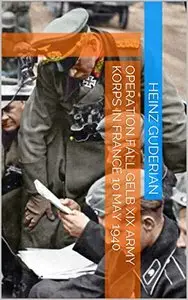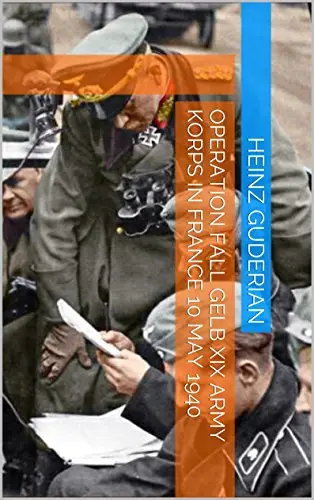Operation Fall Gelb XIX Army Korps in France 10 May 1940 by Heinz Guderian
English | Feb 22, 2015 | ASIN: B00TWVP24C | 209 Pages | EPUB/MOBI/AZW3/PDF (Converted) | 12 MB
English | Feb 22, 2015 | ASIN: B00TWVP24C | 209 Pages | EPUB/MOBI/AZW3/PDF (Converted) | 12 MB
The Blitzkrieg in the Low Countries. "THE Germans are bound to attack in the late spring or early summer. They simply cannot wait until we and the British attain superiority in manpower and materials." It is the French Minister at the Hague speaking, the clever and charming Baron de Vitrolles, and the date of my conversation with him is January 1940. He continues: "Where will the battle be fought out? There are two traditional battlefields in Europe – Lombardy and Flanders. The second will be the scene of the big battle of the present war, just as it was of another great war – Waterloo. The Germans will attack via the Netherlands and Belgium and the decisive battle of this war will develop somewhere within a radius of fifty miles from Waterloo. It will be a war of movement. And in this kind of warfare we always have been superior to the Teutons." The Minister's words, except the last sentence, were almost prophetic. They showed that responsible French quarters knew that the attack on their country was bound to come and that it would come via the Low Countries.
Why did France and the Low Countries not do everything in their power to forestall the German move? The answer is a sad one. It is a tragic story of lack of statesmanship in Belgium and the Netherlands, where King Leopold and Queen Wilhelmina refused to conclude an alliance with the Western Powers or to make military arrangements between the respective general staffs. It is a story, moreover, of incompetence, inefficiency and fifth column activities both in the Low Countries and in France. For two years the Low Countries had been living in constant fear that their mighty neighbor, Nazi Germany, might launch a sudden attack against them and would start its advertised Blitzkrieg against France across their territories. Though this fear had existed for a long time, both Belgium and the Netherlands refused to make alliances or initiate staff talks with the Western Powers. And though they refused to make arrangements for the crisis, they expected these two Powers to help them when it came. As far back as the end of March 1939 the world press published alarming reports of Germany's intention to launch an attack against Switzerland and Holland. All the small neutrals felt it necessary to take certain military precautions. Then in August 1939 the war clouds started to gather in earnest. Again the small countries were compelled to effect precautionary measures. Both Holland and Belgium took for granted that if war should break out over Danzig, the Western Powers would try to help Poland by moving against Germany; whereupon Germany, to counteract this move, would launch her motorized divisions into the Low Countries with a view to pushing through into Northern France. Now Belgium had been constructing considerable defense works ever since 1931. As the threat of war became more imminent she increased the pace. Holland, owing to Socialist and other pacifist influences and a long tradition of neutrality, had considerably neglected her defenses. Yet she also started to develop fortifications and defense works, coupled with inundation preparations. When I arrived in Holland in October 1939 there were persistent rumors, based on the concentration of forty Nazi divisions opposite the Low Countries, of an imminent German attack. At the beginning of November the situation became so tense that King Leopold, tipped off by German friends, rushed to The Hague to see Queen Wilhelmina in the hope that the two countries might avoid an invasion by making a conciliatory offer to Berlin jointly. The meeting of the two rulers took place on November 6. The next day steel-helmeted police, armed with carbines and revolvers, suddenly appeared around all public buildings in Dutch cities. Today we know that the Dutch Nazis had organized a putsch for November 11. But the authorities discovered the plan in time and arrested many Nazis, among them several score officers and soldiers.



